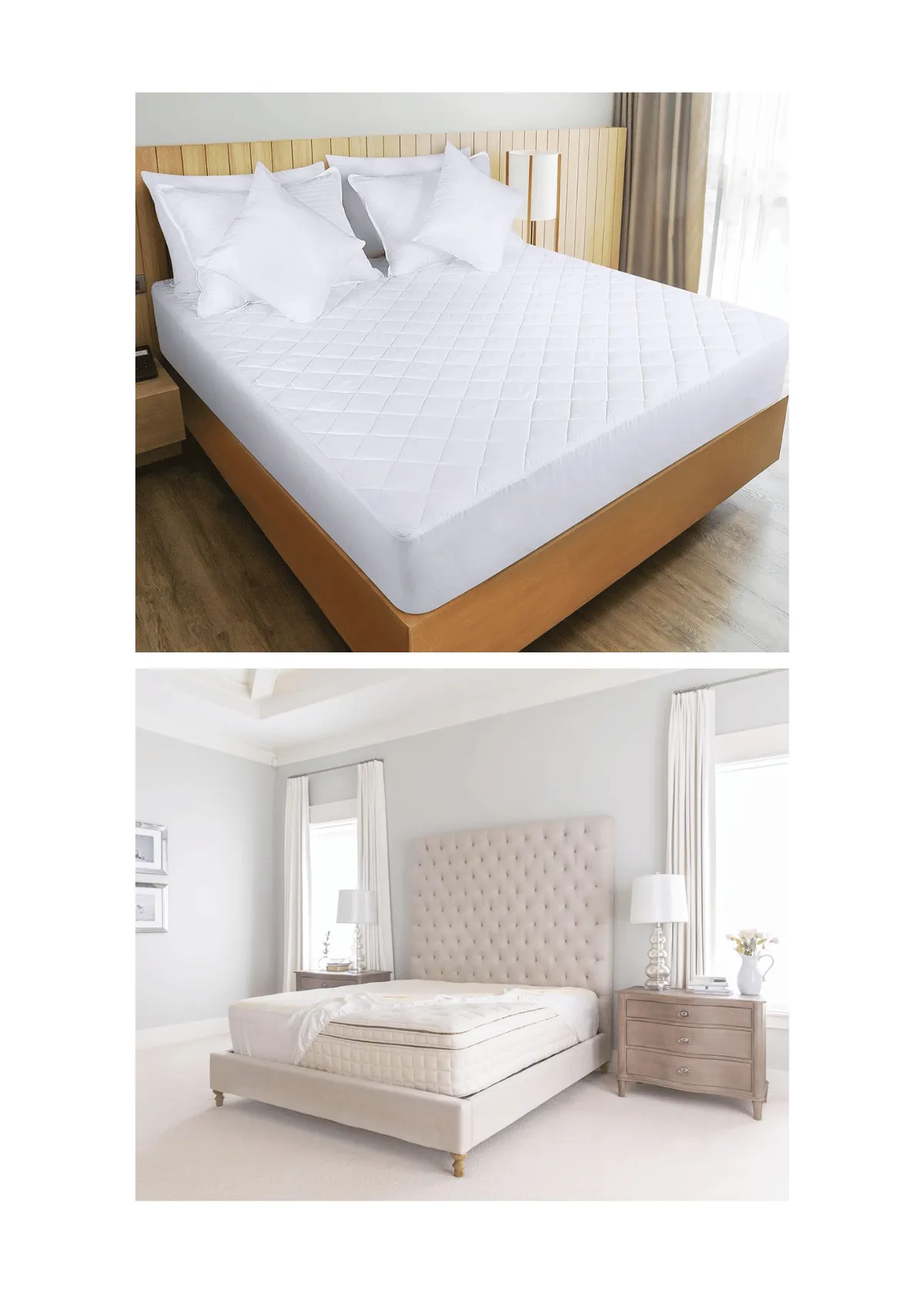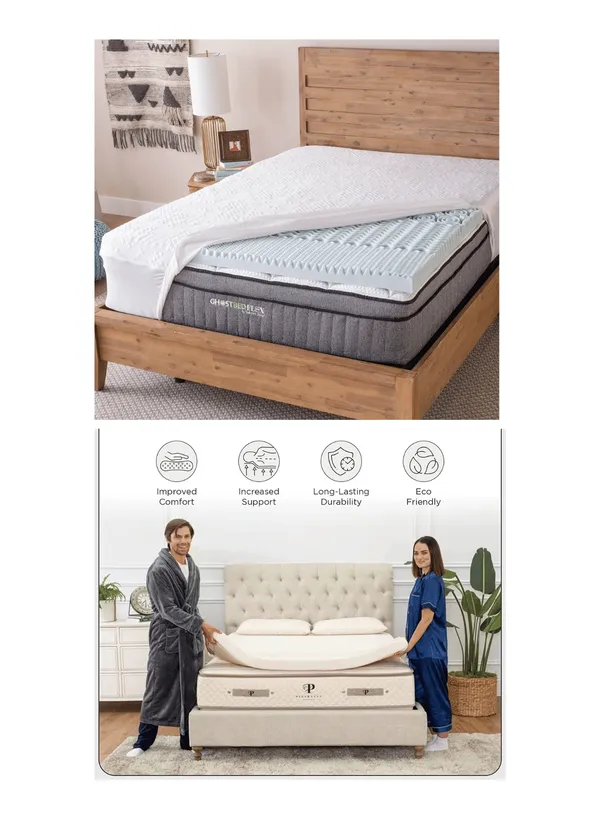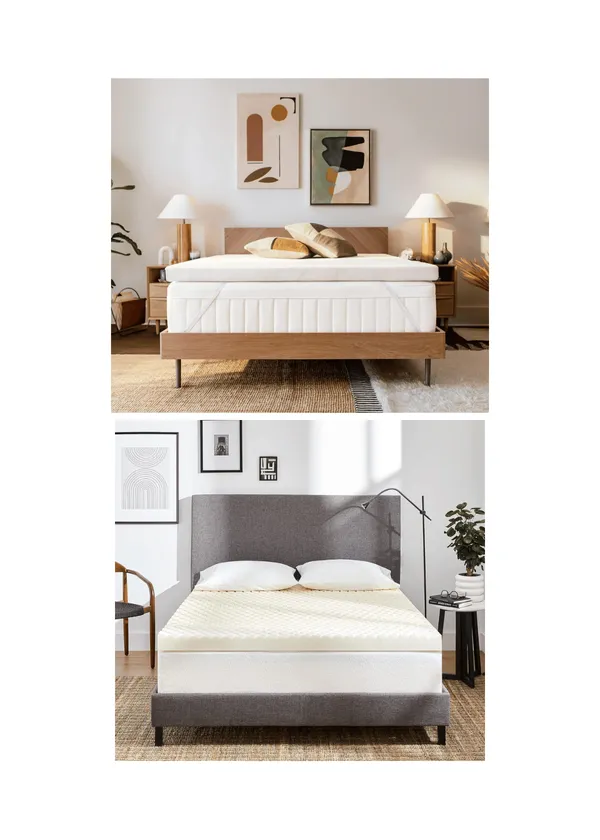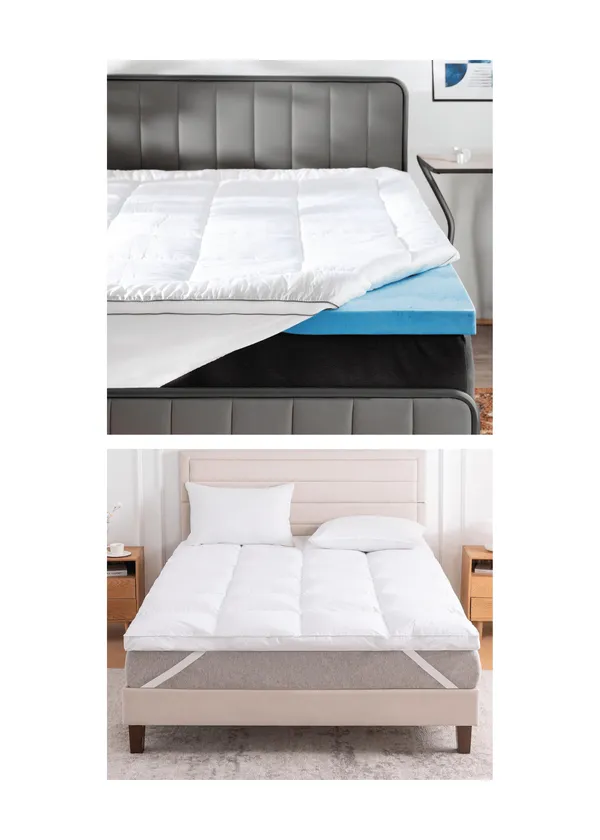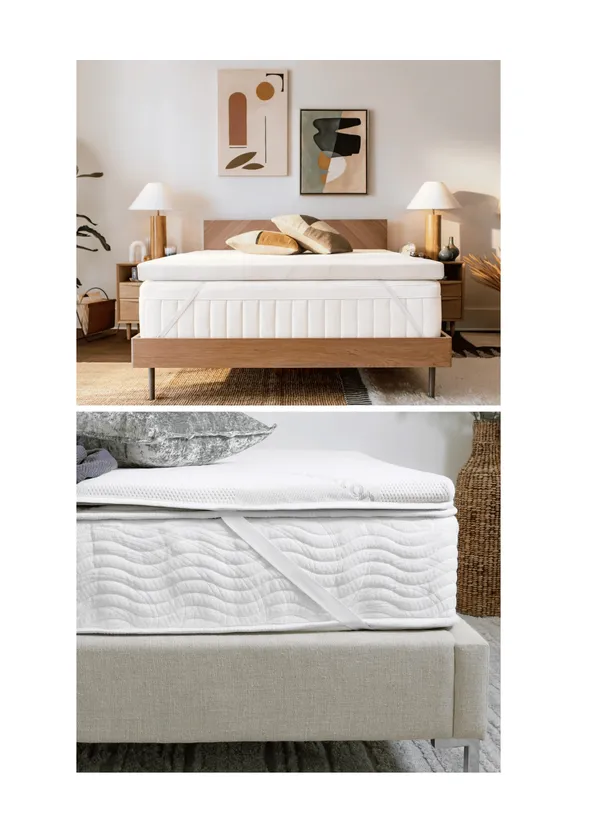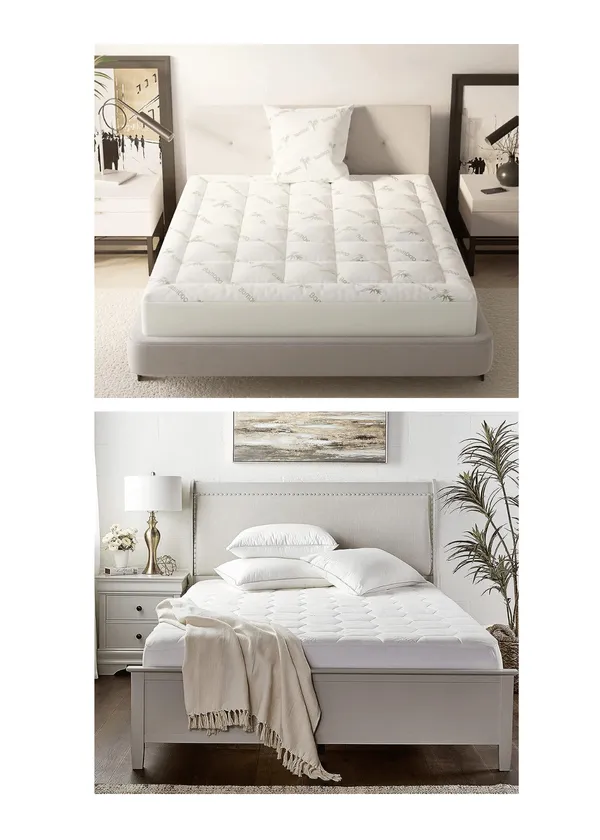Do you ever find yourself tossing and turning, yearning for a restful night’s sleep?
I understand how frustrating it can be.
While a good mattress is essential, the addition of carefully chosen mattress padding can truly transform your sleep experience.
It has the potential to regulate body temperature, offer a more comfortable sleep, and alleviate your sleep concerns, bringing you closer to that restful night's sleep you've been yearning for.
Imagine the relief and comfort you could experience with the right mattress padding, a step closer to the sleep you deserve.
This comprehensive guide delves into the world of mattress padding, arming you with the confidence and knowledge to find the perfect fit for your unique sleep needs.
I will explore the benefits, explore different materials, and equip you with strategies to address specific sleep concerns.
Mattress Padding, Mattress Pad, and Mattress Topper: Unveiling the Differences
Get ready to embark on a journey of transformation.
By selecting the right mattress padding, you can unlock the potential for deeper, more rejuvenating sleep and wake up each morning feeling refreshed and ready to take on the day.
Imagine the possibilities of the right mattress padding, inspiring you to change for better sleep.
Understanding the differences between mattress padding, pads, and toppers is crucial—empowering. With his knowledge, you will choose the right bed accessory for your unique sleep needs, putting you in control of your sleep environment.
Mattress Padding:
Mattress padding typically refers to the quilted layer integrated into the mattress cover. It adds a basic level of softness and comfort but offers minimal support or protection. Unlike a pad or topper, mattress padding is a permanent part of the existing mattress and cannot be removed or adjusted.
Mattress Pad:

A mattress pad is an easily removable layer that enhances comfort and protects the mattress. It adds extra plushness and shields the mattress from spills, allergens, and dust mites.
Mattress pads are generally thinner and easier to clean, often machine washable. Adding a mattress pad can extend the life of the current mattress by relieving pressure, limiting motion transfer, and improving comfort for different sleep styles.
Mattress Topper:

A mattress topper is a thicker, more substantial layer placed on top of a mattress to significantly alter its feel. Using materials like memory foam, latex, or wool, toppers provide enhanced comfort, support, and pressure relief. They cater to specific sleep needs, offering improved alignment, softness, or cooling properties.
Mattress Padding vs. Mattress Pad vs. Mattress Topper
Mattress padding is a built-in feature of the mattress, providing basic comfort. In contrast, mattress pads and toppers are removable and customizable layers. Pads offer additional plushness and protection, while toppers provide significant support and comfort adjustments. Unlike padding, all three enhance comfort, but only pads and toppers can be added or removed as needed.
Demystifying Mattress Pad Materials: Choosing the Right Memory Foam Mattress Topper
Selecting the perfect mattress pad hinges on understanding the unique properties of different materials.
A. Memory Foam: The King of Comfort and Pressure Relief
Memory foam, a favored choice for mattress pads, is renowned for its pressure-conforming properties, which can significantly enhance your sleep experience.

Benefits:
- Conforming Support: Memory foam molds to your body’s curves, distributing weight evenly and reducing pressure points on your back, hips, and shoulders. This can significantly improve comfort and alleviate pain.
- Motion Isolation: Memory foam absorbs motion, minimizing sleep disruption from your partner’s movements.
Drawbacks:
- Potential Heat Trapping: Traditional memory foam can trap body heat, causing discomfort for hot sleepers. Look for pads with cooling gel infusions or ventilated designs for better breathability.
- Off-gassing Concerns: Some memory foam pads may emit a slight odor upon initial use. Opt for pads certified by CertiPUR-US to ensure they meet safety standards and have minimal off-gassing.
Choosing the Right Memory Foam Pad:
- Density: Higher-density memory foam offers firmer support, while lower-density provides a softer, more cradling feel. Choose based on your preference for a firmer or more comfortable sleeping surface.
- Thickness: Thin memory foam pads (1-2 inches) add subtle comfort and pressure relief, while thicker pads (3-4 inches) can significantly alter the feel of your mattress, providing a more luxurious sink-in sensation.
Sleep Innovations 4-Inch Dual Layer Memory Foam Mattress Topper.
- Memory Foam ComfortThe Sleep Innovations 4-inch Dual Layer Memory Foam Topper combines memory foam with a soft pillow top layer, delivering exceptional comfort and support. Dual Layer Design
- 2 inches of cooling gel memory foam
- 2 inches of plush fiber fill
- Machine washable cover
- Ideal for those seeking pressure relief and a plush sleep surface, this topper enhances the comfort of any mattress.
B. Down and Feather Pads: Luxurious Comfort for All Seasons
Down and feather pads offer a luxurious and naturally breathable sleep experience, making them an excellent choice for enhancing your mattress.
Advantages:
Natural Breathability: One of the primary benefits of down and feather pads is their ability to wick away moisture and promote airflow. This natural breathability of the mattress pad can help regulate your body temperature. If you tend to sleep hot, a down and feather pad can be a game-changer for a more restful sleep.
Plush Feel: Down pillows are renowned for their cloud-like softness, and down pads provide a similar level of luxurious comfort. The plush feel of these pads can make your bed feel more inviting, helping you relax and fall asleep faster.
Considerations:
Maintenance: While down and feather pads offer numerous benefits, they require regular upkeep. Fluffing and airing them out periodically helps maintain their loft and prevents allergens from accumulating. Additionally, they may need dry cleaning occasionally to keep them in optimal condition. If you’re willing to invest a little extra effort in maintenance, the rewards in comfort are well worth it.
Potential Allergen Concerns: These pads might not be suitable for people with allergies to down or feathers. Allergic reactions can disrupt your sleep and overall health. However, hypoallergenic alternatives, such as down alternatives, are made from synthetic materials that mimic the feel of natural down.
Fill Power: When choosing a down pad, pay attention to the fill power, which indicates the down’s fluffiness and insulating ability. A higher fill power means a lighter, more luxurious pad that provides better insulation and comfort.
Down Alternative Options: If you have allergies or prefer a vegan option, consider down alternative pads. These are filled with microfiber or other synthetic materials designed to replicate the softness and warmth of down without triggering allergies.
C. Wool Pads: Temperature Regulation and Natural Benefits

Properties:
Wicks Moisture: Wool excels at absorbing and wicking away moisture, making you dry and comfortable at night. This moisture-wicking property can help regulate your body temperature, providing a cooling effect in the summer and warmth in the winter.
Flame Resistance: One of the unique benefits of wool is its natural flame resistance. This adds a layer of safety to your sleep environment, giving you peace of mind.
Naturally Antibacterial: Wool possesses inherent antibacterial properties, making it resistant to dust mites and allergens. This natural defense helps maintain a cleaner surface, which is ideal for sleepers with allergies or asthma.
Potential Drawbacks:
Cost: Wool pads tend to be more expensive than some other options. Their durability, natural benefits, and superior comfort often justify the higher cost. However, the initial investment might be a consideration for some buyers.
Initial Wool Odor: New wool pads may have a slight sheepish odor when unpacked. This natural scent dissipates with time and airing, but it can be noticeable initially.
Finding the Ideal Wool Pad:
Blended Options: Wool pads blended with cotton or other materials can offer a more affordable and softer feel. These blends can provide the benefits of wool while being more budget-friendly and accessible.
Certifications: Look for certifications such as Oeko-Tex Standard 100 when shopping for a wool pad. This certification ensures that the wool is free of harmful chemicals, giving you confidence in the safety and quality of your purchase.
Sleep & Beyond myDual Wool Mattress Pad

Natural Wool
The Sleep & Beyond myDual Wool Mattress Pad features natural wool, known for its excellent temperature regulation properties.
Sustainable and Comfortable
- Dual wool layers
- Breathable and moisture-wicking
- Eco-friendly materials
Perfect for sleepers seeking a natural and sustainable sleep solution, this pad enhances comfort year-round.
ViscoSoft Copper Pillow Top Mattress Pad
Copper Infused Fabric
The ViscoSoft Copper Pillow Top Mattress Pad utilizes copper-infused fabric, known for its cooling and antimicrobial properties. This unique addition helps keep your sleeping environment fresh.
Enhanced Comfort
- Luxurious pillow top design
- Copper-infused cover
- Hypoallergenic material
This pad provides a balance of softness and support, ideal for hot sleepers and those seeking a hygienic sleep surface.
D. Latex Pads: Sustainable Comfort with Bouncy Support
Latex is a natural, eco-friendly material prized for its supportive and responsive feel. Latex pads offer a unique combination of comfort and sustainability, making them an excellent choice for enhancing your sleep experience.
Advantages:
Natural Material: Latex is derived from rubber trees, making it a sustainable and biodegradable option. This eco-friendly material appeals to those who are conscious of its environmental impact.
Responsive Feel: Unlike memory foam, latex conforms to your body without making you feel stuck. It provides a buoyant, cradling support that many sleepers find comfortable. This responsive feel ensures you can move easily during the night without feeling restricted.
Durability: Latex pads are known for their long lifespan, making them a worthwhile investment. Latex foam is lighter, bouncier, and less conforming than memory foam, offering breathability and durability. This makes latex pads ideal for hot sleepers and those weighing over 200 pounds, as they provide excellent support and temperature regulation.
Disadvantages:
Price Point: Latex pads can be more expensive than other options, such as synthetic materials. However, their durability and comfort often justify the higher cost in the long run.
Potential Allergic Reactions: People with latex allergies should avoid these pads. To avoid adverse reactions, you must ensure you are not allergic to latex before purchasing.
Selecting a Quality Latex Pad:
Talalay vs. Dunlop Processing: There are two main types of latex processing. Talalay latex has a luxurious and softer feel, but Dunlop latex is denser and more supportive. Choose based on your preference for softness or firmness. For instance, the Brooklyn Bedding 3” Talalay Latex Topper is known for its structured, cradling feel, allowing users to comfortably rest on top of it.
Benefits of Latex Mattress Toppers: Latex mattress toppers are durable, supportive, and excellent at heat dissipation. They can last five years or more and provide firm, comfortable support for various sleep positions. Their longevity and supportive nature make them a valuable addition to your bedding.
PlushBeds Natural Latex Topper

Natural Latex
PlushBeds Natural Latex Mattress Topper is engineered from pure latex, offering a resilient and supportive sleep surface. It’s naturally hypoallergenic and resistant to dust mites.
Comfort and Support
- 100% natural latex
- Available in multiple firmness levels
- Excellent durability
This topper is perfect for those wanting a customizable and long-lasting upgrade to their mattress.
E. Alternative Materials: Exploring Other Options
Beyond the core materials mentioned above, there are several other options to consider:
- Gel Grid: Gel grid pads are infused with gel material that helps dissipate heat, making them ideal for hot sleepers.
- Cotton: Cotton pads offer natural breathability and affordability. They may not conform as much as other materials, but they provide a cool and comfortable sleeping surface.
- Hybrid Combinations: Many mattress pads combine different materials to offer a unique blend of benefits. For example, a memory foam and gel grid pad provides pressure relief with cooling properties.
Nolah Mattress Topper

Cooling Comfort
The Nolah Mattress Topper offers exceptional cooling comfort with its innovative AirFoam™ technology. It is designed to dissipate heat, enhance airflow, and ensure a cooler sleep surface for hot sleepers.
Enhanced Support
- Made with Nolah's proprietary AirFoam™
- It provides excellent pressure relief
- Soft yet supportive design
This topper improves the comfort and support of any mattress and adds a luxurious feel to your bed.
Naturepedic Organic Waterproof Mattress Protector Pad
Organic Protection
Naturepedic’s Organic Waterproof Mattress Protector Pad offers superior protection without compromising natural materials. It’s made from organic cotton, ensuring a soft and breathable layer.
Waterproof and Safe
- Organic cotton fabric
- Waterproof barrier
- Free from harmful chemicals
Ideal for families and individuals who value organic and safe bedding options, this pad keeps your mattress protected and clean.
Linenspa Waterproof Sheet and Mattress Protector Pad
Dual Protection
The Linenspa Waterproof Sheet and Mattress Protector Pad combines a waterproof barrier with a soft sheet layer, offering comprehensive protection for your mattress.
Convenient and Comfortable
- Soft fabric top
- Waterproof backing
- Machine washable
This pad is a practical choice for those needing an easy-to-maintain and effective mattress protector.
Addressing Specific Sleep Concerns with Mattress Padding for Pressure Relief
A mattress pad can be a powerful tool for addressing common sleep problems. Here’s how to choose the right pad to target your specific needs:
A. Back Pain Relief: Choosing the Right Pad for Support
A mattress pad can be a powerful tool for addressing common sleep problems. Here’s how to choose the right pad to target your specific needs:
Back pain can significantly disrupt your sleep. Here’s what to look for in a mattress pad for back pain relief:
Factors to Consider:
Firmness Level: A firmer pad, such as one made from memory foam or latex. It can provide better back support and reduce pressure points that contribute to pain. However, some sleepers with lower back pain may prefer a softer pad for pressure relief on the hips and buttocks.
Pressure Point Reduction: Look for pads specifically designed to target pressure points in the lumbar region. These often feature zoned construction with firmer support in the lower back area, which can help maintain proper spinal alignment and alleviate discomfort.
Recommended Materials:
Memory Foam: Memory foam’s pressure-conforming properties can alleviate pressure points and improve spinal alignment. Choose a medium-firm or firm-density pad for optimal back support. A memory foam mattress topper can also provide additional comfort and support, beneficial for back pain relief. Its ability to mold to your body’s shape helps distribute weight evenly, reducing the stress on your back.
Latex (with specific properties): Talalay latex offers a blend of comfort and support and is suitable for softness and firmness. On the other hand, Dunlop latex provides firmer support, which is ideal for some back pain sufferers. Its denser composition helps maintain a sturdy support system, ensuring your spine remains properly aligned throughout the night.
B. Temperature Regulation: Finding a Pad for a Cooler Sleep
Do you wake up feeling hot and sweaty? Here are some tips for choosing a mattress pad that promotes cooler sleep:
Strategies for Hot Sleepers:
Breathable Materials: Opt for pads made from naturally breathable materials like gel grids, latex, or cotton. These materials promote airflow and prevent heat from trapping around your body, helping to keep you cool throughout the night.
Cooling Features: To further enhance cooling, look for pads with gel infusions, ventilated designs, or moisture-wicking properties. Gel-infused pads help dissipate heat, while ventilated designs allow for increased airflow.
Tempur-Pedic Cool Luxury Mattress Pad
Cooling Technology
The Tempur-Pedic Cool Luxury Mattress Pad is designed for hot sleepers. Its advanced cooling technology provides a refreshing sleep surface, ensuring a comfortable night’s sleep.
Comfort and Protection
- Soft and breathable fabric
- Enhanced cooling properties
- It provides a protective layer
This mattress pad is a great addition to improving comfort and temperature regulation.
Addressing Cold Sleepers:
While most mattress pads won’t significantly impact warmth, some materials can help retain heat for cold sleepers. Down and wool pads offer natural warmth and insulation, making them a good choice for those who feel cold at night. Down pads provide a plush, cozy feel, while wool pads offer excellent temperature regulation, keeping you warm without overheating.
C. Side Sleeper Support: Padding for Proper Spinal Alignment
Side sleeping can easily put pressure on your shoulders and hips. Here’s how a mattress pad can help:
Ideal Pad Features:
Pressure Relief: Look for pads that offer targeted pressure relief on the shoulders and hips. Plusher memory foam or down alternative pads can help cradle these areas and promote proper spinal alignment. This targeted support ensures that your body remains neutral, reducing the risk of pain and discomfort.
Thicker Options: A slightly thicker pad (2-3 inches) can provide more cushioning and support for your hips and shoulders. This additional thickness helps distribute your weight more evenly, alleviating pressure points and enhancing overall comfort.
Material Options:
Memory Foam: Plush memory foam can conform to your curves and alleviate pressure points on the shoulders and hips. Its contouring ability helps maintain spinal alignment, making it an excellent selection for side sleepers seeking comfort and support.
Plush Down Alternatives: Down alternative pads offer a similar plush comfort level to down but may be more affordable and hypoallergenic. These pads provide a soft, cushioning layer that can relieve pressure while being a suitable option for those with allergies to natural down.
D. Allergy and Asthma Relief: Selecting Hypoallergenic Pads
Choosing the right mattress pad can significantly improve your sleep quality if you are affected by asthma and allergies. Here are some key considerations:
Materials to Avoid:
Down and Feathers: These natural materials can trigger allergies in some people due to dust mites and other allergens.
Traditional Memory Foam: Some memory foam pads may off-gas chemicals that can irritate allergies, releasing volatile organic compounds (VOCs) that can influence indoor air quality.
Recommended Options:
CertiPUR-US Certified Pads: Look for pads certified by CertiPUR-US to ensure they meet safety standards and have minimal off-gassing. These certifications indicate the foam is made without harmful chemicals.
Synthetic Materials: Synthetic materials like gel grids or hypoallergenic cotton offer a good alternative for allergy sufferers. Gel grid pads promote airflow and reduce the buildup of allergens, while hypoallergenic cotton is gentle on sensitive skin. Shredded memory foam, known for its hypoallergenic properties, can be a good option, though it may present cleaning and odor retention challenges.
Beyond the Pad: Essential Considerations for Optimal Use of Heated Mattress Pads
Now that you’ve chosen the perfect mattress pad to address your sleep needs, let’s explore some key factors for optimal use and long-lasting comfort:
A. Finding the Perfect Fit: Mattress Pad Sizing
- Standard Mattress Sizes:**
- Twin, Twin XL
- Full, Full XL
- Queen
- King
- California King
- Deep Pocket Options: Consider a mattress pad with deep pockets for a thick mattress topper or a plush mattress. These pockets ensure the pad stays securely in place throughout the night. Due to their unique materials and benefits, memory foam mattress toppers can help regulate temperature and provide additional comfort.
B. Keeping Your Pad Fresh: Cleaning and Maintenance Tips
Proper cleaning and maintenance will extend your mattress pad's lifespan and promote a clean sleep environment. Here’s a general guide:
Washing Instructions Based on Material:
Down Alternative and Cotton Pads: Most down alternative and cotton pads can be machine-washed. Always comply with the care instructions on the label to avoid damaging the material. Choose a gentle cycle with mild detergent to keep the pad in good condition.
Memory Foam Pads: These typically require spot cleaning or hand washing. Check the specific care instructions for your pad, and use a mild detergent with lukewarm water for spot cleaning. Avoid soaking the pad, as it can damage the foam structure.
Wool Pads: Wool pads may require special cleaning or professional laundering. Follow the manufacturer’s instructions carefully, as improper washing can shrink or feel the wool.
Drying Recommendations and Avoiding Shrinkage:
Always follow the drying instructions on the care label to avoid shrinkage or damage. Air drying is often recommended, especially for memory foam pads, to prevent heat from breaking down the material. To avoid shrinking, use a low heat setting in the dryer for machine-washable pads.
General Upkeep Strategies for Long-Term Use:
Regular Fluffing and Airing: Regularly fluff and air your mattress pad to maintain its loft and freshness. This helps prevent the pad from becoming flat and uncomfortable over time.
Use a Mattress Pad Protector: Use a mattress pad protector between your mattress pad and fitted sheet for added protection against spills and dust mites. This extra layer can significantly prolong the life of your pad and keep it cleaner.
Ease of Cleaning: Invest in a mattress pad that can be easily cleaned to ensure long-term hygiene. Pads that are easy to wash and dry save you time and effort in maintenance.
Choosing the Right Pad: For optimal comfort and support, selecting the right mattress pad is crucial based on your sleep style and preference. Please ensure that your choice meets your needs for softness, firmness, and ease of maintenance.
C. Investing for the Long Haul: Considering Budget and Durability
Mattress pads come in various price points, depending on the material, size, and features. Here’s what to consider when making your investment:
Expected Lifespan of Different Pad Materials:
- Memory foam pads: 3-7 yearsLatex pads: 7-10 years (or even longer with proper care)Down and wool pads: 5-8 years with regular cleaning and fluffing
Balancing Price with Quality for a Lasting Investment:
To make the best decision, consider the features and benefits of specific memory foam toppers, including their cooling properties and support.
Conclusion: Sweet Dreams Start with the Perfect Pad
Enhancing your sleep with the best mattress toppers can make a difference. Please feel empowered to choose the padding that best suits your needs.
Remember, a small change can lead to a significant improvement in your sleep quality. You can create a supportive and comfortable sleep environment by exploring different materials and benefits.
Here’s to transforming your nights and enjoying a deeper, more rejuvenating sleep tonight!
Frequently Asked Questions
What brand of mattress pad is best?
The best brand of mattress pad often depends on your specific needs and preferences. However, brands like Tempur-Pedic, Sleep Innovations, and Linenspa are highly rated for quality, comfort, and durability. Researching customer reviews can also help in making an informed choice.
What is the best filling for a mattress pad?
The best filling for a mattress pad varies based on individual preferences. Memory foam delivers excellent pressure relief and support, while the down alternative provides a plush, hypoallergenic option. Latex is ideal for those seeking a natural, breathable, and durable choice.
What is the number one best mattress topper?
The Tempur-Pedic TEMPUR-Topper Supreme is often considered the number one best mattress topper. Known for its superior comfort, pressure relief, and durability, it features Tempur material that adapts to your body’s shape, providing personalized support and a restful sleep experience.
Are expensive mattress pads worth it?
Expensive mattress pads can be worth the investment if they offer superior comfort, durability, and specific features that meet your sleep needs. High-quality materials and advanced construction often result in better sleep quality and longer lifespan, justifying the higher cost over time.

